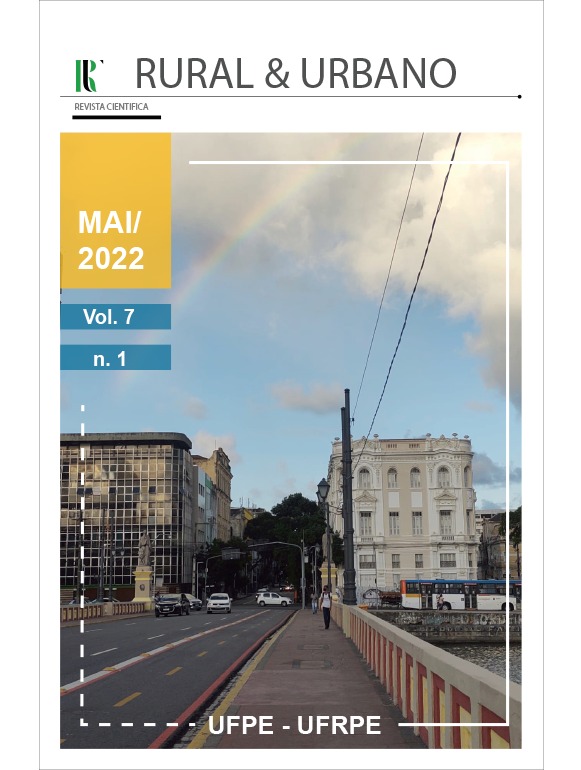Gated Horizontal residential: a generic category for conceptualization of Self-Segregated spaces
DOI:
https://doi.org/10.51359/2525-6092.2022.253496Keywords:
urban segregation; gated community; land subdivision; urban planningAbstract
There are different types of gated development characterized by single-family residential use. The present work aimed to discuss designations and concepts related to these spaces. In order to achieve this aim, different designations were scrutinized, understood as terms used by the real estate market to name residential projects, impregnated with marketing elements and common sense; and distinct concepts, endowed with theoretical content, with the potential to elucidate the socio-spatial processes that characterize such undertakings. Among the various concepts and designations, those that appeared most frequently in the consulted bibliography were selected: gated communities, citadels, barrios cerrados, urbanizaciones cerradas, enclaves fortificados, condomínios fechados, loteamentos fechadosand ensembles résidentiels sécurisés. The concept of gatedhorizontal residential (GHR) was proposed as a generic category capable of characterizing different modalities of these projects.
References
CASTELLS, M. A questão urbana. Trad. de Arlene Caetano. 4. ed. Rio de Janeiro: Paz e Terra, 2009.
DUNKER, C. I. L. Mal-estar, sofrimento e sintoma: uma psicopatologia do Brasil entre muros. São Paulo: Boitempo, 2015.
LEFEBVRE, H. Direito à Cidade. Tradução Rubens Eduardo Frias. 5 ed. São Paulo: Centauro, 2011.
NAVEZ-BOUCHANINE, F. La fragmentation em question: Des villes entre fragmentation spatiale et fragmentation sociale? Paris: L’Harmattan, 2002.
ROSE, N. S. Powers of Freedom: Reframing Political Thought. Cambridge: Cambridge University Press, 2004.
VILLAÇA, F. O espaço intra-urbano no Brasil.São Paulo: Studio Nobel; FAPESP; Lincoln Institute, 2001.
Artigos de Revista:
CALDEIRA, T. P. R. Enclaves Fortificados: a nova segregação urbana. Novos Estudos Cebrap, n. 47, p.155-176, mar.1997.
CAPRON, G. Les ensembles résidentiels sécurisés dans les Amériques: une lecture critique de la littérature. L’espace géographique, vol. 33, n 2, p. 97-113, 2004.
DIKEN, B. From refugee camps to gated communities: biopolitics and the end of the city. Citizenship Studies, v. 8, n. 1, p. 83-106, 2004.
JANOSCHKA, M.; GLASZE, G. Urbanizaciones cerradas: un modelo analítico. Ciudades. Cidade do México: Universidade Autónoma de Puebla, n. 59, p. 9-20, 2003.
LOW, S. The Edge and the Center: Gated Communities and the Discourse of Urban Fear. American Anthropologist,New Series, v. 103, n. 1, p. 45-58, mar. 2001.
MARCUSE, P. The Enclave, the Citadel, and the Ghetto: What has Changed in the Post-Fordist U.S. City? Urban Affairs Review, v. 33, n. 2, p. 228-264, 1997.
SALGUE1RO, T. B. Cidade pós-moderna: espaço fragmentado. Revista Território, v. 111, n. 4, p.39-53, jan./jun. 1998.
Capítulos de Livro:
BLAKELY, EDWARD J.; SNYDER, M.G. Separate places: Crime and security in gated communities. In: FELSON, M.; PEISER R. B. (eds.). Reducing crime through real estate development and management.Washington, D.C.: Urban Land Institute, 1998. p. 53-70.
HIDALGO, R.; BORSDORF, A. Barrios cerrados y fragmentación urbana en América Latina: estudio de las transformaciones socioespaciales en Santiago de Chile (1990-2000). In: HIDALGO, R.; TRUMPER, R. BORSDORF, A. (eds.) Transformaciones urbanas y procesos territoriales. Lecturas del nuevo dibujo de la ciudad latinoamericana. Santiago: Serie GEOlibros, Academia de Ciencias Austriaca y Okanagan University College, 2005. p. 105-122.
LACERDA, N. Fragmentação e integração: movimentos de reestruturação espacial das metrópoles brasileiras. In: RIBEIRO, Ana Clara Torres; LIMONAD, Ester; GUSMÃO, Paulo Pereira de. (Org.). Desafios ao planejamento. Rio de Janeiro: Letra Capital, 2012. p. 21-42.
MAIA, D. S. Lotes e ruas: componentes para análise da produção dos loteamentos fechados. In: SPÓSITO, E. S.; SPOSITO, M. E. B.; SOBARZO, O. (Orgs.) Cidades médias: produção do espaço. São Paulo: Expressão Popular, 2006. p. 155-174.
Referências online:
CABRALES BARAJAS, L. F.&CANOSA ZAMORA, E. Segregación residencial y fragmentación urbana: los fraccionamientos cerrados en Guadalajara. Espiral, v. 7, n. 20, p. 223-253, 2001. Disponível em: <https://doi.org/10.32870/eees.v7i20.1191>. Acesso em: 12 Nov. 2020.
PATRIOTA DE MOURA, C. Condomínios e Gated Communities: por uma antropologia das novas composições urbanas. Anuário Antropológico, v. 2, p. 209-233, 2010. Disponível em: <https://journals.openedition.org/aa/970>. Acesso em 15 Out. 2020.
SPOSITO, E.S. &SPOSITO, M.E.B. Fragmentação socioespacial. Mercator, Fortaleza, v. 19, e19015, 2020. Disponível em: <https://doi.org/10.4215/rm2020.e19015>. Acesso em: 15 Jan. 2021.
Downloads
Published
How to Cite
Issue
Section
License
Copyright (c) 2022 Rafael Rust Neves, Ruskin Fernandes Marinho de Freitas

This work is licensed under a Creative Commons Attribution-NonCommercial-ShareAlike 4.0 International License.
Autores que publicam nesta revista concordam com os seguintes termos:
a) Autores mantém os direitos autorais e concedem à revista o direito de primeira publicação, com o trabalho simultaneamente licenciado sob a Creative Commons Atribuição-Não Comercial-Compartilha Igual 4.0 Internacional  , que permite o compartilhamento do trabalho com reconhecimento da autoria e publicação inicial nesta revista.
, que permite o compartilhamento do trabalho com reconhecimento da autoria e publicação inicial nesta revista.
b) Autores têm autorização para assumir contratos adicionais separadamente, para distribuição não-exclusiva da versão do trabalho publicada nesta revista (ex.: publicar em repositório institucional ou como capítulo de livro), com reconhecimento de autoria e publicação inicial nesta revista.
c) Autores têm permissão e são estimulados a publicar e distribuir seu trabalho online (ex.: em repositórios institucionais ou na sua página pessoal) a qualquer ponto antes ou durante o processo editorial, já que isso pode gerar alterações produtivas, bem como aumentar o impacto e a citação do trabalho publicado.

